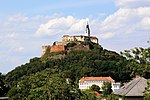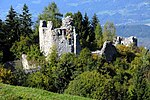Schloss Gutenberg
- View a machine-translated version of the German article.
- Machine translation, like DeepL or Google Translate, is a useful starting point for translations, but translators must revise errors as necessary and confirm that the translation is accurate, rather than simply copy-pasting machine-translated text into the English Wikipedia.
- Do not translate text that appears unreliable or low-quality. If possible, verify the text with references provided in the foreign-language article.
- You must provide copyright attribution in the edit summary accompanying your translation by providing an interlanguage link to the source of your translation. A model attribution edit summary is
Content in this edit is translated from the existing German Wikipedia article at [[:de:Schloss Gutenberg]]; see its history for attribution. - You may also add the template
{{Translated|de|Schloss Gutenberg}}to the talk page. - For more guidance, see Wikipedia:Translation.
| Schloss Gutenberg | |
|---|---|
| Styria, Austria | |
 | |
| Type | Castle |
Schloss Gutenberg is a castle in Styria, Austria. Schloss Gutenberg is situated at a height of 567 meters.[1]
Schloss Gutenberg stands on a prominent rock by the Raabklamm in Gutenberg an der Raabklamm parish.
The castle is a foundation of Luitold III of Waldstein, who moved into the castle in 1185. The castle has belonged to the Stubenberg family since 1288. The oldest section from the 12th century was supplemented by a 2-story bailey that is protected by two moats. The outer moat is bridged today, the inner was filled in. The castle was remodeled and expanded, mixing the medieval style with Renaissance elements. An irregular four-story building complex with an almost pentagonal footprint and similarly pentagonal courtyard. The rustic gate faces south.
Schlosskapelle St. Pankras
The southwest corner with the Chapel of Saint Pancras constitutes the oldest section of the castle. The chapel, originally constructed over three stories like a tower, with galleries in both upper stories, was dedicated in 1365. Entry is on the first gallery with frescoes that were isolated by the later addition of a dome. The frescoes from the second half of the 14th century show St. Alfa, St. James the Elder, the Martyrs of Ten Thousand, St. George, and the Caravan of the Three Kings. The Romanesque window behind the altar now has modern glass.
Farm Buildings
The farm buildings bear the dates 1659 and 1710.
Street Chapels
A chapel from about 1721 stands on the access road. The second chapel is from the third quarter of the 18th century. Two stone figures, St. Anna and St. John Nepomuk, originally from Schloss Wieden at Kapfenberg, also stand along the access road. Both are by Veit Königer, from about 1770.
See also
References
- ^ Schloss Gutenberg Height and Location
Federal Monument Office (Publisher): Dehio-Handbuch. Die Kunstdenkmäler Österreichs: Steiermark (ohne Graz). Gutenberg. Schloss. Verlag Berger, Horn/Wien 1982/2006, 2. unveränderte Auflage, S. 156f, ISBN 3-85028-422-0.
Burgenland 






Carinthia Lower Austria Salzburg Styria Tyrol Upper Austria Vorarlberg
 | This Styria location article is a stub. You can help Wikipedia by expanding it. |
- v
- t
- e
  | This article about a castle in Austria is a stub. You can help Wikipedia by expanding it. |
- v
- t
- e










